2011 Week 3
Completed the fourth week of field school and the third in the field. By this point most of the students are familiar with the basic excavation and recording procedures while they work on their techniques of getting straight walls and flat floors. Both of these techniques are important for maintaining control over the context of the recovered materials. There is only so much teaching one can do, the rest comes from practice. To the students it may seem like they are doing the same things over and over again. Yet each time, we can see great improvements in the final result.
This week is characterized, more than anything else, by the arrival of summer. Temperatures in the 90s, with high humidity, makes it difficult to think, let alone be moving dirt. We have tried to follow the first rule of archaeology in a Chesapeake summer – seek shade – as well as drinking lots of water. On Sunday, the hottest day thus far, Abdoulie Sey, a student from Gambia, jokingly told me that “the Gambia has come to Maryland.” Certainly it has a tropical feel but the class is doing well under difficult conditions.
One of our goals for the summer is not only to trace out the fences but to excavate a number of fence segments. We began that work this week.
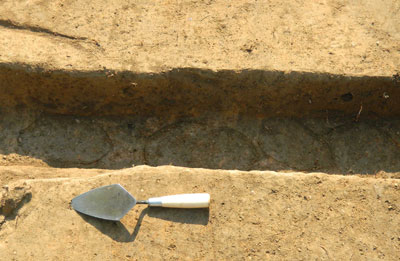
Fence segment partially excavated to reveal the molds of the logs.
The type of fence most commonly encountered is termed a palisado and was constructed by digging a trench and placing logs or split wood upright in it. A cross piece was often attached at the top to provide stability. Eventually, the fence was removed or rotted away, leaving no trace above ground. Through the years, the area was plowed and the upper portion of the fence was disturbed. What is left for us to find is evident as a dark soil against the bright yellow-orange of the subsoil. We excavate partially into the trench to reveal the molds of the wood which made up the fence. In this case, the elongated nature of the molds suggests that this fence was intentionally removed by rocking the logs parallel to the length of the trench.
One of the most informative views of the molds is the profile on the end of the excavated segment.
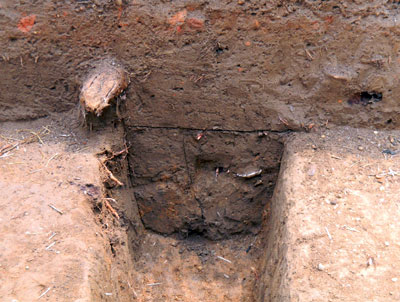
Profile view of a paling mold at the end of an excavated fence segment.
In the accompanying photo, the timber mold is evident on the right side, with an oyster shell sticking out of it. The log was narrowed towards the bottom and set against the west side of the trench. Both of these traits are suggestive of certain fence building practices. While the removal of the fence makes it impossible to know the actual shape of the pales, the narrowing indicates that some care was taken in preparing the wood before it was put in the trench. Placement of the mold within the trench can often indicate the space that was being enclosed. Pales were most often placed to the outside of the area the fence was to run around.
The first of our squares in the southwestern portion of the site was excavated this week.
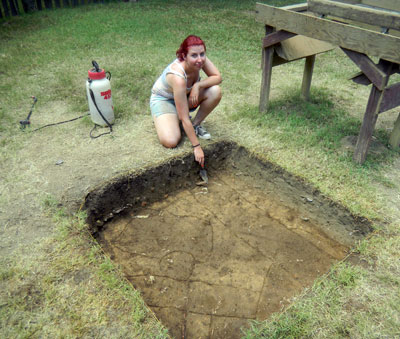
Katharine Wade points to a newly discovered fence line in the unit.
Previous work in the 1980s had shown as many as four fences running in front of the Calvert House but ending in the area southwest of the structure. This, combined with the lack of samples on the west side (due to the presence of the 1840s Brome-Howard House) made the understanding of this portion of the yardscape problematical. As the kitchen was in the western portion of the Calvert house, it may be that a permanent gate was left in the fences to provide access to the spring at the bottom of the nearby ravine. Our goal for the summer is to open a number of units in this area and try to determine the fencing scheme. Of course, it does not bother us that the most intense artifact distribution is found in this area as well.
From the plow zone in this unit, we sent five bags, full of artifacts and debris, to the lab on Saturday. A normal plow zone unit, in other parts of the site, generally produces only one bag of materials. Deposition is so heavy in this area because it is part of the kitchen midden of the Calvert House. One indication of the proximity of the kitchen is the large quantity of bone found here. In other units done this summer, bone is rare, if found at all. This unit yielded an entire paper bag just of bone fragments. Such materials provide an unequalled perspective on diet at the site and, comparatively, through the rest of the 17th-century Chesapeake.
A couple of items were found in this unit that already has sparked the interest of the students. The first, found in the topsoil of this unit, was a small piece of ceramic with the letters “ELL” impressed in it. The crew immediately added an H to the front of this which led to all sorts of speculation. Fortunately, we found several other pieces of the same vessel which solved the mystery.
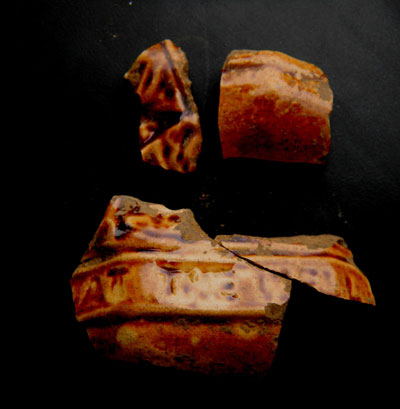
Fragments of a 19th-century teapot partially marked “AT THE WELL.”
This was part of a 19th-century teapot with a design illustrating a scene from the bible. Known as “Rebecca at the Well,” it relates how Rebecca’s generosity and hospitality made her an ideal wife for Isaac. This theme of hospitality was adopted in 19th-century America as the symbol of a gracious home and these teapots were made in large quantities.
The other artifact, a glass wine bottle seal, was found in the plow zone.
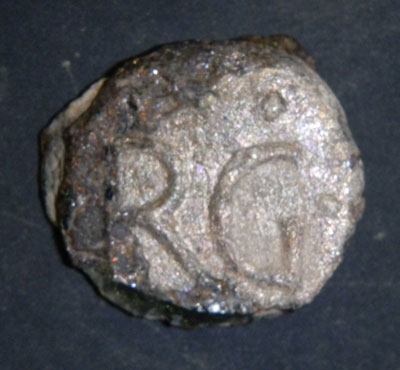
Wine bottle seal marked with “RG.”
In the late 17th century, tavern owners often had bottles marked with their initials so that they could get them back from customers. Individuals would also mark their bottles so that they could have them filled by a distributor and then sent back. Several seals have been found at the Calvert House over the years, including at least a couple marked with “IB.” These relate to John Baker, who ran an Ordinary or Inn at the Calvert House for a period in the late 17th century. No one with the initials “RG” is known to have run the Ordinary at the Calvert House. However, Robert Gellie ran a tavern very close to the State House. In fact, Gellie’s Ordinary was so disturbing to the Assembly and Court, that the Governor’s Council asked the City authorities to shut it down. There is no way to know if the “RG” on the seal was Robert Gellie but such an identification would fit both the right time and function.


